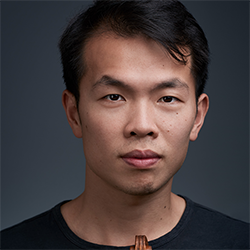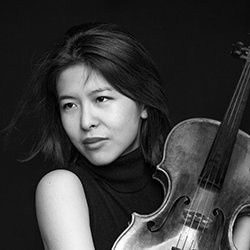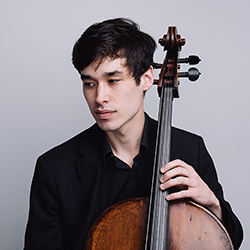
Ike See, Wenhong Luo & Richard Narroway
On Friday 22 July, Ike See, Wenhong Luo and Richard Narroway take to the Elisabeth Murdoch Hall stage to perform works by Penderecki, Dohnányi and Beethoven as part of Melbourne Recital Centre's Great Performers series. Explore the program in this excerpt from the official program notes, written by Stella Joseph-Jarecki.
Together Ike See, Wenhong Luo and Richard Narroway are a musical force to be reckoned with, each deservingly lauded for their fine musicianship, passion and vitality. The trio presents an evening of electrifying and exquisite music for strings, bringing new light to works by Penderecki, Dohnányi and Beethoven.
About the music
Ludwig van
Beethoven
(1770-1827)
String Trio
in C minor, Op.9 No.3
At the time he completed his Op.9 String Trios, Ludwig van Beethoven was in the process of establishing himself as a composer within Viennese musical society. The three trios were dedicated to Beethoven’s patron Count Johann Georg von Browne, described by the composer as the ‘first Maecenas of his Muse’ in the dedication page.
The Op.9 collection marked Beethoven’s third (and last) foray into the string trio genre. His renowned string quartets would come soon after- musicologists have theorised the compelling string quartets produced by Wolfgang Amadeus Mozart and Joseph Haydn prompted Beethoven to cut his teeth on the string trio form before tackling quartets.
The melodic voice of the String Trio in C minor is predominantly carried by the violin. This part may have been written for violinist Ignaz Schuppanzigh, who regularly collaborated with the composer. At over eight minutes, the first movement of the trio is the longest of the four. Within seconds we are thrust into a stormy landscape, with a striking descending motif of four notes. This motif is skillfully utilised throughout the movement as the basis for both transitional and thematic moments. The second adagio con espressione movement moves away from the darkness and into the light with hushed dynamics and elegantly introspective phrases in the key of C major. The scherzo third movement bounces along with a spring in its step, presenting a series of ornate flourishes. The trio’s energy picks up an edge of agitation in the final movement before gently winding down to a muted conclusion.
Krzysztof
Penderecki
(1933-2020)
String Trio
Krzysztof Penderecki is one of the most well-known Polish composers of the 20th century, alongside Witold Lutosławski and Graznya Bacewics. Penderecki was very productive throughout his composing career, writing over 100 instrumental and vocal pieces and another 120 for film, theatre and television.
It is interesting to note Penderecki’s writing for string ensemble is scattered across this vast output. His first two string quartets were completed in the 1960s, with the third coming forty years later in 2008 and the fourth in 2016. Penderecki’s only string trio was written in 1990 and revised by the composer shortly after.
Conductor and cellist Kenneth Woods describes the composer’s use of groupings of three within the allegro molto first movement: ‘The screamingly dissonant chords that launch the work (heard three times) are a combination of three triads [chord entities]: G major, G sharp minor and B flat diminished. These chords preface three cadenzas, which introduce three strongly differentiated musical personae – the morose viola, the mercurial cello and the volcanic violin.’
In the vivace second movement, Penderecki has the three voices march through contrapuntal lines unfolding in canon. The composer puts the timbral and dynamic range of stringed instruments on full display, moving from jagged and scratchy textures to curt plucked notes. A sense of tightly wound tension is maintained until the final seconds.
Ernő
Dohnányi
(1877-1960)
Serenade in
C, Op.10
Ernő Dohnányi penned his Serenade in C, Op.10 in 1902 when he was in his mid-twenties. By this time Dohnányi had already attracted acclaim across Europe as a concert pianist, and over the next four decades he would become one of Hungary’s most prominent musical figures. This was not limited to the sphere of performing- Dohnányi held the positions of musical director of Hungarian Radio, chief conductor at the Budapest Philharmonic, and served two stints as director of the Budapest Academy of Music.
The serenade gained popularity as a musical form in the 18th century and would contain anywhere from four to ten musical dance movements. Dohnányi harks back to these traditional serenades with an opening march movement: in upper-class society, this introduction would signal the arrival of the patron who paid for the evening’s music. The march develops into a secondary theme with clear Hungarian character, while not quoting a specific national folk melody.
The yearning refrain of the second romanza movement is performed by the viola, who then provides arpeggiated accompaniment to the violin and cello in a turbulent middle section. The third movement is a frenzied passage of rhythmically jagged motifs. Dohnányi creates a sense of constantly shifting motion by placing the weight of these rhythmic figures against a 6/8-time signature.
An elegiac tone is fostered throughout the fourth movement, following a theme and variations structure. Dohnányi shifts gear dramatically with the finale, moving at breakneck speed through virtuosic fast-paced material.

About the Artists
Ike See
Singapore-born violinist Ike See is a member of the Australian Chamber Orchestra and enjoys a varied career as a chamber musician, soloist, leader and director. A three-time first prize winner at the Singapore National Violin Competition, Ike has performed as a soloist with the ACO, Adelaide Symphony Orchestra, Singapore Symphony Orchestra, Orchestra of the Music Makers, and Singapore National Youth Orchestra.

Wenhong Luo
Violist Wenhong Luo is the 3rd prize winner at the 12th Lionel Tertis Viola competition and the 19th Joannes Brahms competition. After making her debut in China with the China broadcast symphony orchestra at age of 16, playing the Walton Viola concerto, she moved to London and studied at the Royal Academy of Music. A native of Beijing, China, she devotes herself to both solo and chamber music playing, and with the great passion of delivering the music to different communities.

Richard Narroway
Australian cellist Richard Narroway enjoys an international career as a sought-after performer, recording artist, and teacher. He has given performances across Australia, North America, Europe, and Asia, in prestigious venues such as the Kennedy Center, Chicago Symphony Center, Koerner Hall, and the Sydney Opera House. Deeply committed to community engagement and innovation, he takes a particular interest in devising projects that bring classical music to a wider audience.
Program note excerpt by Stella Joseph-Jarecki.
Tickets to Ike See, Wenhong Luo and Richard Narroway's Great Performers recital are available here.
You might also be interested in
-
-
-
Explore the program notes in advance

